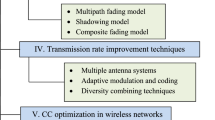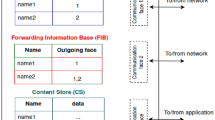Abstract
Cooperative communications greatly enhance the point-to-point link capability to against channel fading, and such performance gain is expected to large wireless ad hoc networks. However, current cooperative networking is based on ideal assumptions of completely known network information and centralized optimization, which is practically infeasible to large ad hoc networks requiring unscalable control signaling overhead. In this paper, the exact throughput of practical cooperative ad hoc network is provided, in which users make autonomous decisions with regard to their network usage based on the current network conditions and their individual preferences. Since preference of each node is shown by the achievable data rate estimated from the channel state information (CSI) of links of each source-destination pair, the cost of acquiring CSI is considered in the throughput analysis. Furthermore, the cooperation beneficial condition and the operation algorithm of each node to guarantee the network operating at the highest throughput are proposed. The proposed algorithm provides a way to control network-level performance by local operations among nodes.










Similar content being viewed by others
References
Laneman, J., Tse, D., & Wornell, G. (2004). Cooperative diversity in wireless networks: Efficient protocols and outage behavior. IEEE Transactions on Information Theory, 50(12), 3062–3080.
Sendonaris, A., Erkip, E., & Aazhang, B. (2003). User cooperation diversity. Part i. System description. IEEE Transactions on Communications, 51(11), 1927–1938.
Tao, X., Xu, X., & Cui, Q. (2012). An overview of cooperative communications. IEEE Communications Magazine, 50(6), 65–71.
Yang, D., Fang, X., & Xue, G. (2012). Game theory in cooperative communications. IEEE Transactions on Wireless Communications, 19(2), 44–49.
Kramer, G., Gastpar, M., & Gupta, P. (2005). Cooperative strategies and capacity theorems for relay networks. IEEE Transactions on Information Theory, 51(9), 3037–3063.
Kim, Y., & Beaulieu, N. (2014). Relay advantage criterion for multihop decode-and-forward relaying systems. IEEE Transactions on Wireless Communications, 13(4), 1988–1999.
Nosratinia, A., Hunter, T., & Hedayat, A. (2004). Cooperative communication in wireless networks. IEEE Communications Magazine, 42(10), 74–80.
Mukherjee, A. (2013). Diffusion of cooperative behavior in decentralized cognitive radio networks with selfish spectrum sensors. IEEE Journal of Selected Topics in Signal Processing, 7(2), 175–183.
Beres, E., & Adve, R. (2008). Selection cooperation in multi-source cooperative networks. IEEE Transactions on Wireless Communications, 7(1), 118–127.
Krikidis, I., Rong, B., & Ephremides, A. (2011). Network-level cooperation for a multiple-access channel via dynamic decode-and-forward. IEEE Transactions on Information Theory, 57(12), 7759–7770.
Sirkeci-Mergen, B., & Gastpar, M. (2010). On the broadcast capacity of wireless networks with cooperative relays. IEEE Transactions on Information Theory, 56(8), 3847–3861.
Han, J., Baek, J., Jeon, S., & Seo, J. (2014). Cooperative networks with amplify-and-forward multiple-full-duplex relays. IEEE Transactions on Wireless Communications, 13(4), 2137–2149.
Zhou, Y., & Zhuang, W. (2013). Beneficial cooperation ratio in multi-hop wireless ad hoc networks. In Proceedings IEEE INFOCOM, April 2013, pp. 450–454.
Zhu, Y., & Zheng, H. (2008). Understanding the impact of interference on collaborative relays. IEEE Transactions on Mobile Computing, 7(6), 724–736.
Goldsmith, A., Effros, M., Koetter, R., Medard, M., Ozdaglar, A., & Zheng, L. (2011). Beyond shannon: The quest for fundamental performance limits of wireless ad hoc networks. IEEE Communications Magazine, 49(5), 195–205.
Sheng, Z., Leung, K., & Ding, Z. (2011). Cooperative wireless networks: From radio to network protocol designs. IEEE Communications Magazine, 49(5), 64–69.
Weber, S. P., Andrews, J., Yang, X., & de Veciana, G. (2007). Transmission capacity of wireless ad hoc networks with successive interference cancellation. IEEE Transactions on Information Theory, 53(8), 2799–2814.
Conti, M., Gregori, E., & Maselli, G. (2004). Cooperation issues in mobile ad hoc networks. In Proceedings IEEE International Conference on Distributed Computing Systems Workshops, March 2004, pp. 803–808.
Scaglione, A., Goeckel, D., & Laneman, J. (2006). Cooperative communications in mobile ad hoc networks. IEEE Signal Processing Magazine, 23(5), 18–29.
Sheng, Z., Ding, Z., & Leung, K. (2009). Interference subtraction with supplementary cooperation in wireless cooperative networks. In IEEE international conference on communication ( ICC), June 2009, pp. 1–5.
Haenggi, M., Andrews, J., Baccelli, F., Dousse, O., & Franceschetti, M. (2009). Stochastic geometry and random graphs for the analysis and design of wireless networks. IEEE Journal on Selected Areas in Communications, 27(7), 1029–1046.
Baccelli, F., & Blaszczyszyn, B. (2009). Stochastic geometry and wireless networks: Volume 1: THEORY, ser. foundations and trends(r) in networking. Now Publishers. [Online]. Available: http://www.google.com.tw/books?id=H3ZkTN2pYS4C
Baccelli, F., Blaszczyszyn, B., & Muhlethaler, P. (2006). An aloha protocol for multihop mobile wireless networks. IEEE Transactions on Information Theory, 52(2), 421–436.
Baccelli, F., & Zuyev, S. (1997). Stochastic geometry models of mobile communication networks. In J. H. Dshalalow (Ed.), Frontiers in queueing: Models and applications in science and engineering (pp. 227–244). Boca Raton: CRC Press.
Weber, S. P., Yang, X., Andrews, J., & de Veciana, G. (2005). Transmission capacity of wireless ad hoc networks with outage constraints. IEEE Transactions on Information Theory, 51(12), 4091–4102.
Toumpis, S., & Goldsmith, A. (2003). Capacity regions for wireless ad hoc networks. IEEE Transactions on Wireless Communications, 2(4), 736–748.
Sheng, Z., Goeckel, D., Leung, K., & Ding, Z. (2009). A stochastic geometry approach to transmission capacity in wireless cooperative networks. In IEEE 20th international symposium on personal, indoor and mobile radio communications, September 2009, pp. 622–626.
Tang, X., Alouini, M.-S., & Goldsmith, A. (1999). Effect of channel estimation error on m-qam ber performance in rayleigh fading. IEEE Transactions on Communications, 47(12), 1856–1864.
Ramanan, S., & Walsh, J. (2010). Distributed estimation of channel gains in wireless sensor networks. IEEE Transactions on Signal Processing, 58(6), 3097–3107.
Jones, V., & Raleigh, G. (1998). Channel estimation for wireless ofdm systems. In The bridge to global integration. IEEE global telecommunications conference and GLOBECOM, vol. 2. pp. 980–985.
Gong, X., Chandrashekhar, T. P. S., Zhang, J., & Poor, H. V. (2012). Opportunistic cooperative networking: To relay or not to relay? IEEE Journal on Selected Areas in Communications, 30(2), 307–314.
Ozdaglar, A. (2008) Networks challenge: Where game theory meets network optimization. tutorial. In Kschischang f (ed.), Proceedings international symposium on information theory (ISIT), July 2008.
Osborne, M., & Rubinstein, A. (1994). A course in game theory. Cambridge: MIT Press.
Han, Z. (2012). Game theory in wireless and communication networks: Theory, models, and applications. Cambridge: Cambridge University Press.
Al Rawi, A. F., Aissa, S., Tsimenidis, C. C., & Sharif, B. S. (2014). Game theoretic framework for future generation networks modelling and optimization. IEEE Transactions on Wireless Communications, 13(3), 1153–1163.
Berger, J. (1985). Statistical decision theory and Bayesian Analysis, ser. Springer series in statistics. New York: Springer.
Feng, H., Wang, H., Dai, L., & Cimini, L. J. Jr. (2014). To cooperate or not to cooperate: An outage analysis of interference-limited wireless networks. IEEE Transactions on Wireless Communications, 13(2), 822–833.
Altieri, A., Rey Vega, L., Piantanida, P., & Galarza, C. (2013). Analysis of a cooperative strategy for a large decentralized wireless network. IEEE/ACM Transactions on Networking, PP(99), 1–1.
Haenggi, M. (2005). On distances in uniformly random networks. IEEE Transactions on Information Theory, 51(10), 3584–3586.
Bletsas, A., Khisti, A., Reed, D., & Lippman, A. (2006). A simple cooperative diversity method based on network path selection. IEEE Journal on Selected Areas in Communications, 24(3), 659–672.
Muller, A., & Speidel, J. (2008). Relay selection in dual-hop transmission systems: Selection strategies and performance results. In Proceeding IEEE International Conference on Communications (ICC), May 2008, pp. 4998–5003.
Lee, J., Wang, H., Andrews, J., & Hong, D. (2011). Outage probability of cognitive relay networks with interference constraints. IEEE Transactions on Wireless Communications, 10(2), 390–395.
Weber, S., Andrews, J., & Jindal, N. (2010). An overview of the transmission capacity of wireless networks. IEEE Transactions on Communications, 58(12), 3593–3604.
Baccelli, F., Blaszczyszyn, B., & Muhlethaler, P. (2006). An aloha protocol for multihop mobile wireless networks. IEEE Transactions on Information Theory, 52(2), 421–436.
Hasan, A., & Andrews, J. (2007). The guard zone in wireless ad hoc networks. IEEE Transactions on Wireless Communications, 6(3), 897–906.
Haenggi, M., & Ganti, R. K. (2009). Interference in Large Wireless Networks. NOW: Foundations and Trends in Networking.
MacKenzie, A. B., DaSilva, L. A., & Tranter, W. (2006). Game theory for wireless engineers. San Rafael: Morgan and Claypool Publishers.
Srivastava, V., Neel, J., MacKenzie, A., Menon, R., DaSilva, L., Hicks, J., et al. (2005). Using game theory to analyze wireless ad hoc networks. IEEE Communications Surveys Tutorials, 7(4), 46–56.
Johari, R., & Berry, R. (2009). Game theory in networks. Hanover: NoW Publishers.
Privault, N., & Torrisi, G. (2011). Density estimation of functionals of spatial point processes with application to wireless networks. SIAM Journal on Mathematical Analysis, 43(3), 1311–1344.
Nowak, R. (2003). Distributed em algorithms for density estimation and clustering in sensor networks. IEEE Transactions on Signal Processing, 51(8), 2245–2253.
Seetharam, A., Bhattacharyya, A., Naskar, M., & Mukherjee, A. (2008). Estimation of node density for an energy efficient deployment scheme in wireless sensor network. In Communication systems software and middleware and workshops, 2008. COMSWARE 2008. 3rd International Conference on, January 2008, pp. 95–98.
Safarinejadian, B., & Menhaj, M. B. (2011). Distributed density estimation in sensor networks based on variational approximations. International Journal of Systems Science, 42(9), 1445–1457.
Author information
Authors and Affiliations
Corresponding author
Appendix
Appendix
1.1 Proof of Lemma 1
The proof is similarly presented in [21, 46]. The term \((1+P_{hr}\phi )p\lambda \) denotes the transmitting node density of the network.
1.2 Proof of Lemma 2
We rewrite
The rest of proof is similar to [21, 46].
1.3 Proof of Theorem 3
From other player’s decisions only changed the interference level, that is, \(\phi \) in (16), (17) and (18). No matter what other players’ decisions are, (19) and (20) are the dominant strategies for players with \(P_th_{S,r}d_{S,r}^{-\alpha }>P_th_{S,D}d^{-\alpha } +P_th_{r,D}d_{r,D}^{-\alpha }\) and \(P_th_{S,r}d_{S,r}^{-\alpha }<P_th_{S,D}d^{-\alpha } +P_th_{r,D}d_{r,D}^{-\alpha }\), respectively.
1.4 Proof of Theorem 3
According to Lemma 3, when \(p\le p_{max}\), all players would choose strategy DT if \(\lambda <\lambda _{th}(p)\), and choose strategy CC if \(\lambda \ge \lambda _{th}(p)\). \(\lambda _{th}(p)\) depends on \(p\). When \(p> p_{max}\), each player whose type satisfies \(P_th_{S,r}d_{S,r}^{-\alpha }>P_th_{S,D}d^{-\alpha } +P_th_{r,D}d_{r,D}^{-\alpha }\) would choose strategy CC and each player whose type satisfies \(P_th_{S,r}d_{S,r}^{-\alpha }<P_th_{S,D}d^{-\alpha } +P_th_{r,D}d_{r,D}^{-\alpha }\) would choose strategy DT.
Rights and permissions
About this article
Cite this article
Yeh, YN., Chen, KC. & Chen, YC. Throughput in A Cooperative Network and Channel State Information. Wireless Pers Commun 81, 1481–1510 (2015). https://doi.org/10.1007/s11277-015-2509-9
Published:
Issue Date:
DOI: https://doi.org/10.1007/s11277-015-2509-9




